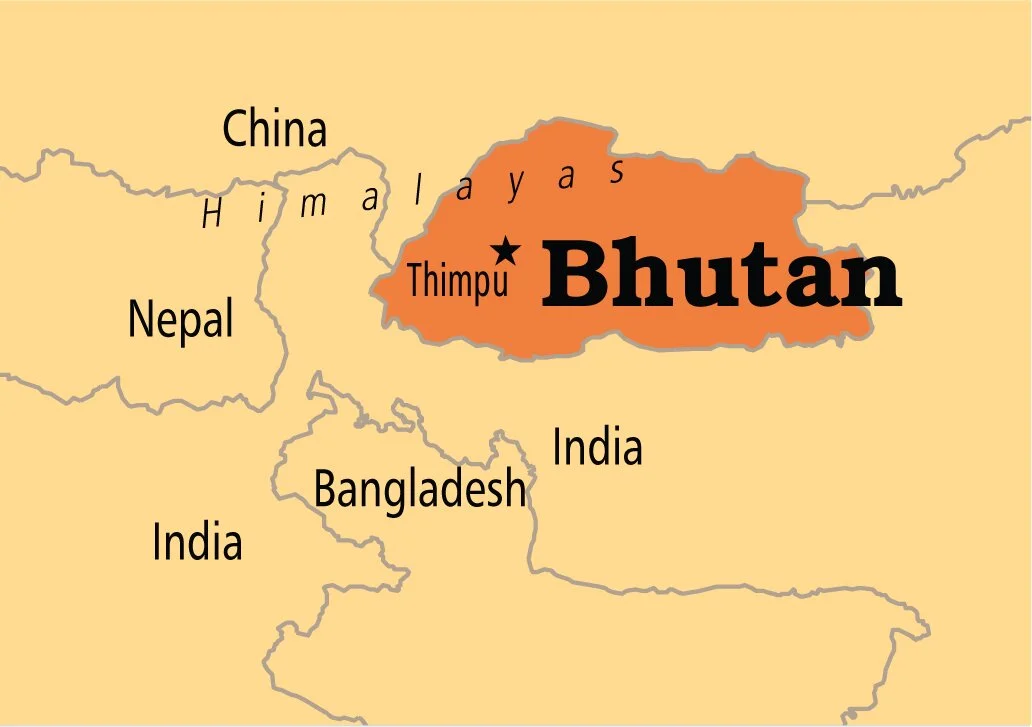Strengthening India-Bhutan Partnership | 13 Nov 2025
For Prelims: Five Year Plan, Gelephu Mindfulness City Project, STEM, MSMEs.
For Mains: Key Outcomes of PM Modi’s Bhutan Visit, India-Bhutan Relations, Challenges, and Future Partnership Directions.
Why in News?
India’s Prime Minister undertook a State Visit to Bhutan to attend the 70th birthday celebrations of Bhutan’s 4th king (Druk Gyalpo), Jigme Singye Wangchuck, father of the current monarch.
What are the Key Highlights of India’s State Visit to Bhutan?
- Economic and Developmental Assistance: India reaffirmed its support for Bhutan’s 13th Five Year Plan and Economic Stimulus Programme, and announced backing for the Gelephu Mindfulness City project and an Immigration Check Post at Hatisar, Assam.
- India and Bhutan signed 3 New MoUs on renewable energy, health, and mental health.
- Hydropower Diplomacy: India and Bhutan inaugurated the 1020 MW Punatsangchhu-II Project and resumed work on the 1200 MW Punatsangchhu-I Project, strengthening their hydroelectric partnership.
- India also extended a Line of Credit of Rs 40 billion for new energy projects in Bhutan.
- Connectivity and Infrastructure: Both sides reaffirmed commitment to strengthen cross-border connectivity and infrastructure, building on initiatives like the Darranga Check Post and Jogigopha Multimodal Terminal.
- They acknowledged progress on the Cross-Border Rail Links connecting Gelephu–Kokrajhar and Samtse–Banarhat.
- Trade and Agriculture Cooperation: India institutionalised the supply of essential commodities and fertilisers to Bhutan, with the first consignment ensuring uninterrupted agricultural inputs.
What are the Key Areas of Cooperation Between India and Bhutan?
- Trade and Economic Ties: India and Bhutan maintain a free trade regime under the India-Bhutan Trade Agreement (1972, revised 2016).
- Since 2014, India's trade with Bhutan has more than tripled—from USD 484 million in 2014–15 to USD 1,777.44 million in 2024–25 and is the leading source of investments (50% of total).
- Development Partnership: India has been Bhutan’s key development partner since the 1960s, providing Rs. 4,500 crore (73% of external grants) during the 12th Five-Year Plan for agriculture, ICT, health, industry, transport, energy, urban development, and education.
- 4 hydropower projects (2,136 MW) are operational and Punatsangchhu-I & II (2,220 MW) are under construction; India imported INR 2,448 crore of electricity from Bhutan in 2022.
- Cultural Ties: India provides 1,000+ scholarships annually to Bhutanese students, offers Indian Technical and Economic Cooperation (ITEC) training, and promotes cultural, educational, and scientific exchanges through the India-Bhutan Foundation (2003).
- Bhutanese pilgrims visit sites like Bodh Gaya, Rajgir, Nalanda, and Sikkim, while India supports Bhutanese cultural projects including Lhakhang (temple) construction.
- Emerging Areas of Cooperation: Bilateral ties cover digital, financial, and space technology, with Bhutan using RuPay, BHIM, and Digital Drukyul, launching the India-Bhutan SAT (2022), opening a Ground Earth Station (2023), and getting help to address STEM teacher shortages.
What are the Key Challenges in India-Bhutan Relations?
- China Factor and Geopolitical Balancing: Bhutan’s border talks with China, especially over Doklam, impact Indian security, as shown by the 2017 standoff. Seeking strategic autonomy, Bhutan aims to balance relations and diversify partnerships, which may affect its exclusive ties with India.
- Economic Dependency: Bhutan’s economy relies heavily on India as its top trade partner, donor, and hydropower market, creating a power asymmetry and perceptions of dominance.
- Bhutan’s tourism policy, with a high Sustainable Development Fee, limits Indian visitors, affecting people-to-people ties and border economies.
- Environmental Concerns: Multiple dams on Bhutanese rivers raise concerns in downstream Indian states over water flow, siltation, and extreme weather impacts e.g., Bhutan’s Tala dam overflow floods Dooars region in West Bengal.
- Border and Security Issues: Despite a largely peaceful border, India and Bhutan face occasional security concerns like illegal trade, smuggling, and insurgent movement, making border management alongside economic exchange challenging.
How can India-Bhutan Partnership Be Strengthened?
- Economic Diversification: Promote joint ventures, MSMEs, and technology-driven industries to reduce Bhutan’s dependence on India and explore sectors like renewable energy, IT, pharmaceuticals, and eco-tourism.
- Expand collaboration from hydropower to solar and wind energy for a diversified and resilient energy portfolio.
- Strengthening Strategic Ties: India should maintain quiet but firm diplomatic support for a swift resolution of Bhutan-China border talks, safeguarding all parties’ security interests.
- Expand Technological Cooperation: Deepen India’s role in space, satellite, and digital projects like telemedicine, education networks, and internet gateways, and provide STEM and ICT capacity-building as Bhutan’s main source of technical expertise.
- Cultural and Soft Power: Launch Himalayan Cultural Corridor with Nepal to preserve Buddhist heritage via digital archives and create a Young Leaders Fellowship for Bhutanese professionals to gain experience in Indian institutions.
- Joint Water Resource Management: Shift from hydropower to integrated river basin management, emphasizing water quality, flood control, and climate adaptation as a model for transboundary cooperation.
Conclusion
India-Bhutan relations are transitioning from a traditional model of dependency to a dynamic, multifaceted partnership encompassing trade, energy, digital technology, education, and cultural cooperation. Future success depends on strategic adaptation, economic diversification, fostering people-to-people ties, and leveraging geographical proximity to create a sustainable strategic and regional advantage for both nations.
|
Drishti Mains Question: "Beyond hydropower, the future of India-Bhutan ties lies in cooperation in digital, space, and green technologies." Elaborate on this statement and discuss the way forward. |
Frequently Asked Questions (FAQs)
1. When did India and Bhutan establish formal diplomatic relations?
Formal diplomatic relations between India and Bhutan were established in 1968, based on the 1949 Treaty of Friendship, which was renewed in 2007.
2. Which hydropower projects were inaugurated or resumed during PM Modi’s 2025 Bhutan visit?
Punatsangchhu-II (1020 MW) was inaugurated, and work on Punatsangchhu-I (1200 MW) resumed.
3. How much bilateral trade does India account for in Bhutan’s total trade?
India accounts for approximately 73% of Bhutan’s total trade and is the largest FDI source, contributing 50% of foreign investments.
UPSC Civil Services Examination, Previous Year Question (PYQ)
Mains
Q. Border management is a complex task due to difficult terrain and hostile relations with some countries. Elucidate the challenges and strategies for effective border management. (2016)

